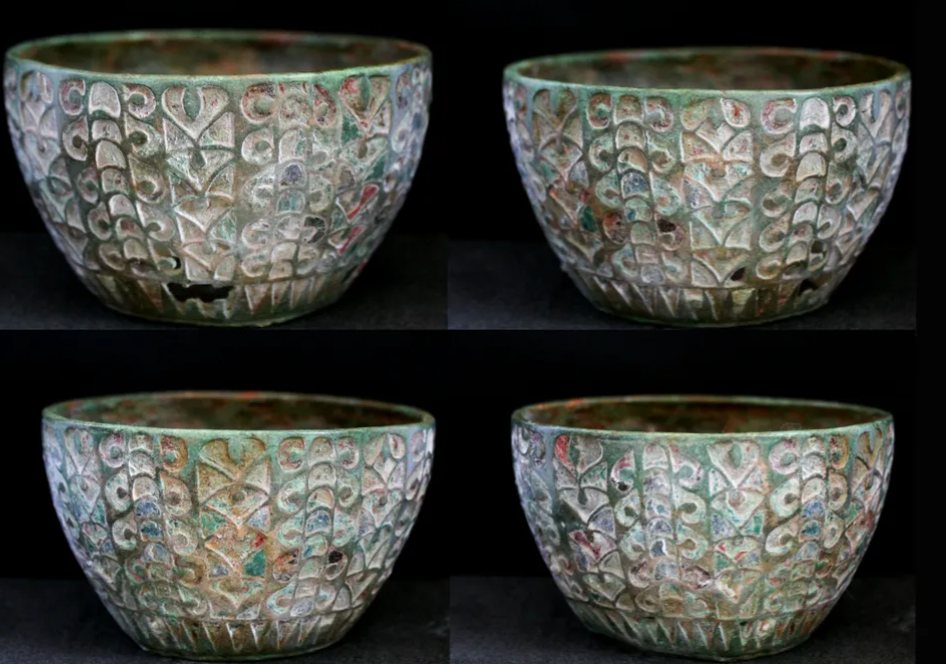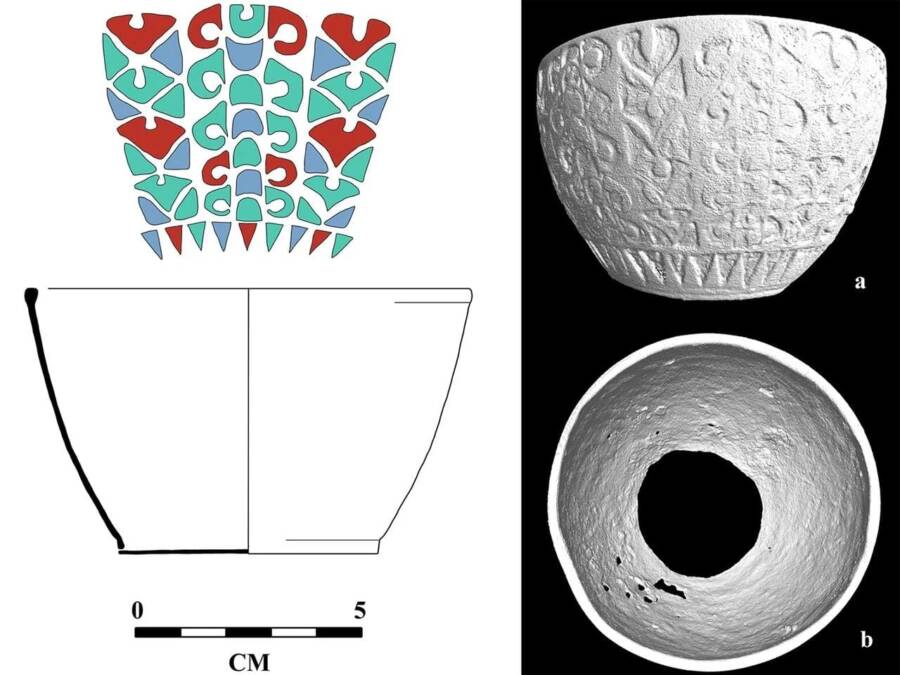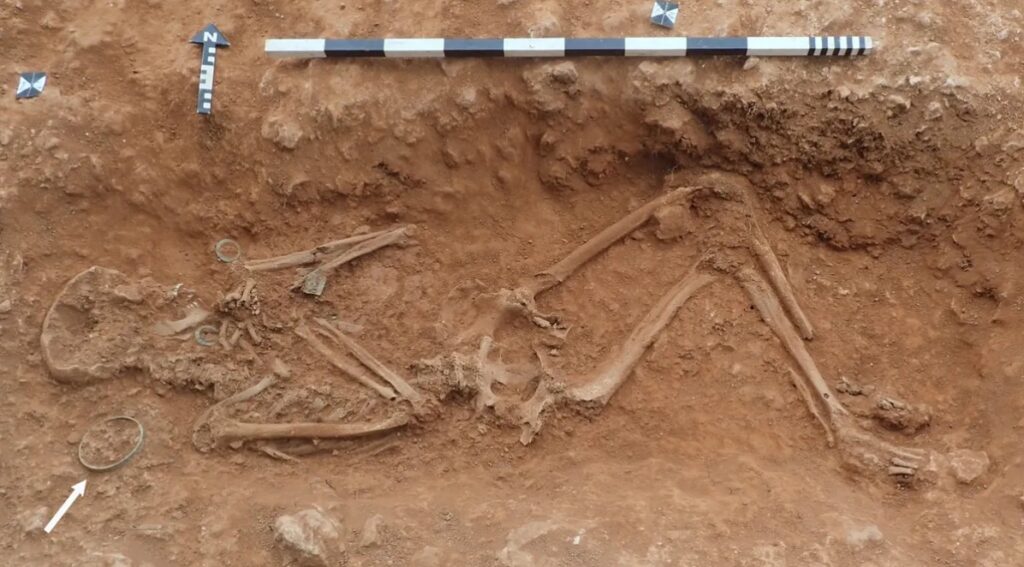A Fascinating Discovery in Anglo-Saxon England
In a groundbreaking archaeological excavation in Scremby, Lincolnshire, researchers have uncovered a remarkable artifact: a 3rd-century Roman goblet buried alongside an Anglo-Saxon teenage girl. The burial, dating to the 6th century CE, contained the goblet placed near the girl’s head, accompanied by two ornate brooches. Known as the “Scremby Cup,” the vessel has left archaeologists stunned due to the traces of pig fat preserved inside.
This unexpected find not only deepens our understanding of early Anglo-Saxon burial practices but also opens up intriguing questions about cultural intersections in post-Roman Britain.
The Scremby Cup: A Roman Artifact with New Meaning
The Roman goblet, originally crafted for drinking purposes, likely dates back to the 3rd century, during the height of the Roman Empire’s occupation of Britain. However, its presence in a grave from the 6th century Anglo-Saxon period marks a clear shift in its use and significance.
Rather than serving as a drinking vessel, the cup’s inclusion in the burial suggests it held ritualistic, symbolic, or practical importance. The traces of pig fat found within the cup are particularly noteworthy. Scientific analysis of the residues indicates the fat was organic and likely had some functional purpose.

Pig Fat — Symbolism, Medicine, or Ritual?
The discovery of pig fat in the Scremby Cup raises several possibilities:
- Medicinal Uses: Animal fats were widely known for their medicinal properties during this period. They were applied to wounds to promote healing, used as ointments for skincare, or even ingested to treat intestinal issues.
- Symbolic and Ritual Significance: Pig fat may have held ceremonial meaning. Pigs were valuable animals in early Anglo-Saxon society, often associated with feasting and sacrifice. Placing pig fat in a burial might have symbolized nourishment for the afterlife, purification, or a ritual offering.
- Practical Preservation: There is also a chance the pig fat served as a natural preservative, intentionally or incidentally sealing the vessel’s interior and aiding its survival across centuries.
The Scremby Cup highlights how objects from one culture could be imbued with entirely new meanings and purposes by another.

Was the Goblet a Heirloom or a Scavenged Treasure?
The origin of the Roman goblet within an Anglo-Saxon burial remains a mystery. Archaeologists propose two main theories:
- A Treasured Heirloom: The goblet may have been passed down through generations, signifying the girl’s family as one of wealth, power, or prestige. Its inclusion in her burial suggests the vessel held deep sentimental or symbolic value.
- Scavenged or Reclaimed: Alternatively, the goblet might have been rediscovered in a Roman burial or abandoned settlement and reappropriated by the Anglo-Saxons. This practice of “recycling” Roman artifacts was not uncommon during the early medieval period.
Either explanation points to the complex relationship between Anglo-Saxon communities and the remnants of Roman Britain.
Insights into the Girl’s Status and Burial Context
The discovery also provides significant clues about the teenage girl’s social status. The presence of a rare Roman artifact alongside two brooches suggests she may have belonged to an elite family. Brooches were not mere adornments but symbols of wealth and social identity, often associated with individuals of high rank.
Her burial reflects a carefully curated ritual, emphasizing the importance of objects that transcended time and culture.

Cultural Intersection in Post-Roman Britain
The Scremby Cup serves as a powerful symbol of the cultural crossroads in early Anglo-Saxon England. After the collapse of Roman rule in Britain, the Anglo-Saxon settlers encountered the physical and cultural remnants of Roman civilization. Items like the goblet were not only reused but also reinterpreted, gaining new meanings in Anglo-Saxon society.
This discovery showcases the resourcefulness and adaptability of these communities, as they blended elements of Roman material culture with their own traditions and beliefs.
The Scientific Path Forward
The Scremby Cup continues to be a focus of scientific inquiry. Advanced techniques, such as biomolecular residue analysis and isotope testing, are expected to provide further details about:
- The composition and origin of the pig fat.
- Whether the vessel was locally sourced or imported.
- The burial environment and preservation process.
Researchers hope these studies will unravel more about the cup’s journey through history and its significance within the burial.
A Window into Life and Death in Early Medieval England
The discovery of the Scremby Cup offers a unique glimpse into the lives of early Anglo-Saxon communities and their interactions with a fading Roman legacy. It emphasizes the profound ways in which objects could bridge cultures, carry memories, and symbolize connections between the living and the dead.
As ongoing research uncovers more details, the Scremby Cup promises to remain a key artifact in understanding the transition between Roman and Anglo-Saxon Britain, revealing stories of adaptation, symbolism, and identity.

